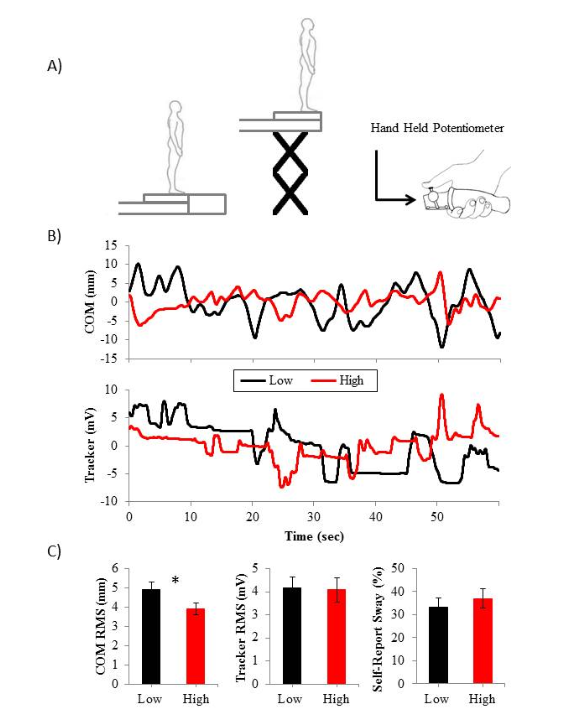Recent evidence has shown that fear of falling, anxiety and arousal are related to significant changes in balance control, as well as increased sensitivity of sensory systems that control balance, including vestibular and proprioceptive inputs in healthy adults. While these threat-related increases in sensory gain likely evolved to enhance survival responses to an imminent threat, they may, under less acute conditions, lead to altered perceptions of balance performance, which may contribute to an increased risk of falling. The current study was designed to examine how changes in threat influence conscious perceptions of postural sway in healthy young adults.
Twenty healthy young adults stood on a force plate that was used to record their centre-of-pressure displacements (COP) and kinematics were used to estimate centre-of-mass (COM) location in the anterior-posterior direction for 60 s trials with their eyes open and closed. During each trial, subjects stood normally while consciously tracking their ongoing sway using a hand-held tracking device recorded in real-time. Each standing trial was performed on ground level (low threat) and at the edge of a hydraulic lift that was raised to 3.2 m (high threat). We hypothesized that if threat alters perceptions of sway, then threat-related changes in tracked sway amplitude will differ from corresponding changes in actual sway. The threat of standing at height significantly increased fear of falling, anxiety and arousal, and decreased balance confidence. Standing in the high compared to low threat condition was associated with a stiffening balance response, where COP and COM displacements decreased in amplitude and increased in frequency. In contrast, subjects reported no significant change in subjective perceptions of sway, and the amplitude of consciously tracked sway using the hand-held device, was not different between threat conditions (Figure 1).

The observed difference between actual balance behavior, and conscious perception of the same movement is consistent with prior reports of subjects feeling unstable at height, even though their actual sway amplitude was unchanged or decreased. This seeming disconnect between conscious perception of sway and actual postural changes with threat may reflect changes in increased sensory feedback gain, or a switch to more conscious motor processing of upright stance. The extent to which fear may influence conscious perceptions of more dynamic and voluntary balance movements is under current investigation, and will provide important insight into how disconnects in balance perception and performance may lead to balance deficits and falls in populations with increased fear of falling.
Publication
Cleworth TW, Carpenter MG. Postural threat influences conscious perception of postural sway. Neurosci Lett. 2016 May 4; 620:127-31.
About the Author

Mark Carpenter
Professor, School of Kinesiology, The University of British Columbia
Mark Carpenter completed his PhD in Kinesiology at the University of Waterloo in 2001, followed by a post-doctoral fellowship at the Karolinska Institute in Stockholm. His research aims to identify the physiological and psychological factors that contribute to balance deficits and falls associated with age, vestibular loss and neurological disease.
Copyright
© 2018 by the author. Except as otherwise noted, the ISPGR blog, including its text and figures, is licensed under a Creative Commons Attribution-ShareAlike 4.0 International License. To view a copy of this license, visit https://creativecommons.org/licenses/by-sa/4.0/legalcode.
ISPGR blog (ISSN 2561-4703)
Are you interested in writing a blog post for the ISPGR website? If so, please email the ISGPR Secretariat with the following information:
- First and Last Name
- Institution/Affiliation
- Paper you will be referencing
